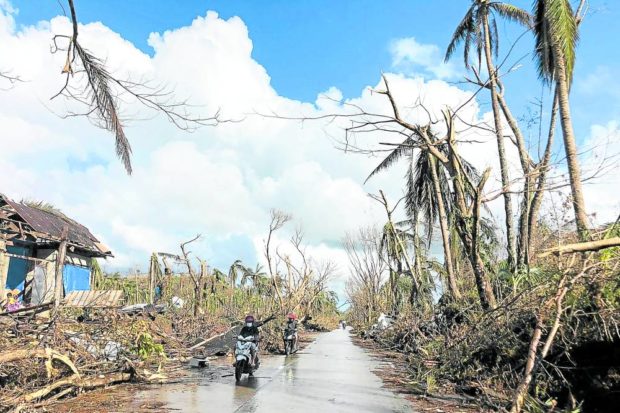Displaced Siargao coastal folk can’t return, may get gov’t land

SHREDDED: Fallen trees and those shredded of their leaves by the sheer fury of the winds of Typhoon Odette (international name: Rai) give no shade under the blazing sun in this photo taken on Dec. 20 of a street on Siargao, four days after the island received the full force of the strongest typhoon to hit the country this year. (Agence France-Presse)
MANILA, Philippines — Residents of coastal areas in typhoon-devastated Siargao will not be allowed to rebuild their homes there and will instead be given land in other parts of the island, according to the Department of Environment and Natural Resources (DENR).
The no-build zone policy is meant to avoid a repeat of the destruction of their houses when Typhoon “Odette” (international name: Rai) struck the island nearly two weeks ago, Environment Undersecretary Benny Antiporda told President Duterte during a meeting at Malacañang on Monday. A video of the meeting was aired on Tuesday.
In response, the President said idle government lands should be given to displaced residents as part of the rehabilitation effort.
“Those idle government land, idle lands of the government [that are] not productive, better give it to the people right away,” Mr. Duterte said.
Antiporda said that the DENR and the Surigao del Norte provincial government “agreed that the people residing in the coastal areas will no longer be permitted to return.”
Article continues after this advertisement“It’s for their safety,” he said. “We are ensuring that the destruction of their houses due to the strong typhoon will not happen again.”
Article continues after this advertisementThe DENR would instead distribute parcels of land to “qualified tenured migrants” under the Protected Area Community-Based Resource Management Agreement [PACBRMA], Antiporda said.
This agreement, which has a 25-year term, is entered into by the DENR and organized tenured migrant communities, or interested indigenous peoples, in protected areas or buffer zones.
Tenured migrant communities refer to communities which have actually and continuously occupied a protected area for five years prior to its designation as such.
Protected area
Siargao was declared a protected area under Proclamation No. 902 in October 1996 by then President Fidel Ramos. It covers an area of about 278,914 hectares of “protected landscape and seascape.”
Antiporda said the DENR was encouraging the municipal governments in Siargao to form “people’s organizations” to “fast-track” the PACBRMA in their localities.
He said the mayors also were advised to identify temporary resettlement sites where the former coastal community residents were to stay until the PACBRMA was awarded.
He did not indicate when these lands might be distributed.
He said the relocation areas would not be far from where coastal residents used to stay.
Apart from tourism, the people of Siargao also rely on fishing for their livelihood.
Siargao is composed of 48 islands and islets and has nine municipalities: Burgos, Dapa, Del Carmen, General Luna, Pilar, San Benito, San Isidro, Santa Monica and Socorro. It has a population of 136,092, according to the 2020 Census.
It is a top tourist and surfing destination. In 2019, the island’s resorts hosted some 200,000 tourists, with foreigners comprising almost half.
Rebuilding houses on the island, whether by the sea or elsewhere, would be a major undertaking for its residents, according to a Greenpeace activist and the UK-based international antipoverty group Oxfam.
The fierce winds of the typhoon tore off the roofs of most houses on the island, said Yeb Saño, executive director of Greenpeace Southeast Asia, who was in Siargao from Dec. 20 until Christmas Day helping set up solar panels for emergency power and charging stations for mobile phones, and distributing community water filters.
Videos and photos from survivors showed the roof and walls of a newly built landmark on the island, the P630.2-million Siargao Island Sports and Tourism Complex (SISTC), had collapsed due to strong winds at the height of Odette’s rampage.
“I’ve never seen anything like that since ‘Yolanda’ wherein most roofs of houses have been blown off,” Saño told the Inquirer in an interview, referring to the November 2013 supertyphoon (international name: Haiyan).Saño said only about 5 percent of the roofs in Siargao remain intact.
“The urgent endeavor right now is to have their houses reconstructed,” he said.
Saño observed that people were trying to quickly rebuild or repair their houses, using any piece of wood and roofing material that they had salvaged from the storm debris.
“There is still hope for them, I see that they are still hopeful despite those events. However, they will still really need all the assistance they can get,” Saño said.
Oxfam Philippines country director Lot Felizco said the government and private sector should prioritize rebuilding houses and the distribution of shelter repair materials along with food and water as there was a pressing need to decongest evacuation sites to avoid the spread of the coronavirus.
“Typhoon survivors already spent Christmas in evacuation centers; let’s not keep them there for New Year’s Day too as we are still battling the COVID-19 pandemic,” Felizco said in a statement.
Evacuation centers are cramped with some rooms occupied by three to four families where it is impossible to observe physical distancing, she said.
Oxfam also raised concerns about privacy and the safety of women and children as there were no partitions separating families from each other. In some evacuation centers, people were also forced to bathe in open areas.
“The lack of water and sanitation facilities make frequent hand-washing and proper hygiene habits more challenging for typhoon survivors,” Felizco said.
Saño warned of a possible “bigger disaster” due to the contamination of drinking water, which has caused diarrhea cases.